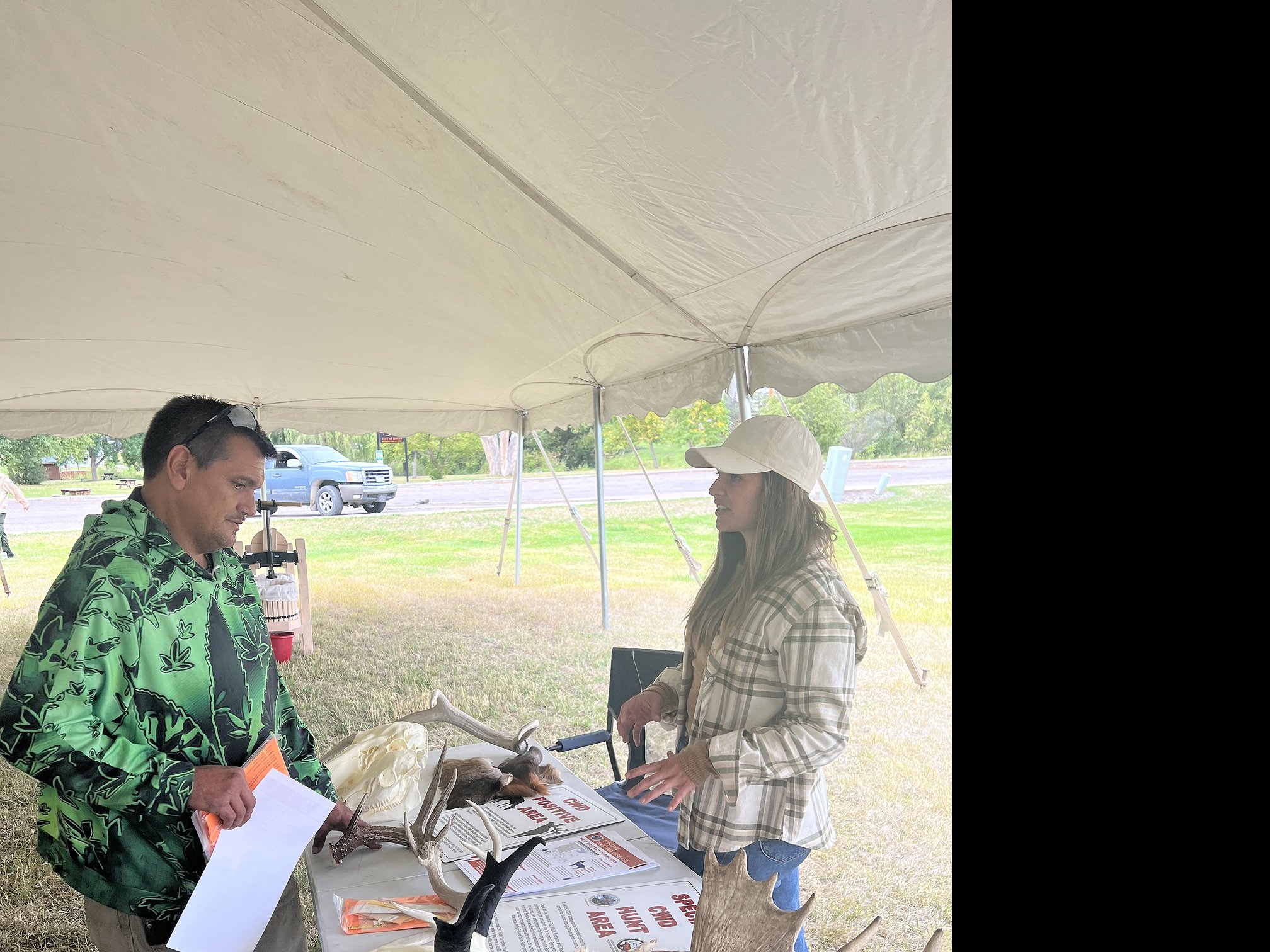Fall Wildlife Festival provides info, cider presses
The Fall Wildlife Festival at the Ronan Visitor’s Center welcomed everybody to their fourth annual event on Saturday, Sept. 14. The event festival is sponsored by the Confederated Salish and Kootenai Tribal Natural Resources Department.
Many folks picked boxes of apples, brought their own jugs and jars, and used the three free cider presses to squeeze the delicious juice out of their fruit. Bob Bell took the apple pulp for his compost, which he “cooks” at Kickstart Compost on Round Butte Road so it’s a win for everybody.
Another win is fruit that ripens and is picked and used by someone, called gleaning, according to CSKT Grizzly Management Specialist Payton Adams. He talked about bear safety and attractants. Apples, pears, plums and other fruit are big attractants. Bears might come and pick that luscious fruit for you, climbing on the trees, sometimes breaking the limbs, and leaving huge piles of “evidence” behind.
People can do three things to protect their fruit attractants, Adams said: Fence the tree(s) with an electric fence, cut the tree down, or pick and eat the fruit. He recommended a Facebook page called Mission Valley Fruit Gleaning where people who have fruit and people who want to pick and use fruit can connect.
If you choose to use electric fencing, Russ Talmo, Defenders of Wildlife representative, is a person to buttonhole. He, Adams, who is also grizzly bear conflict manager, and the USDA Wildlife Services collaborate on many projects. They build from 50 to 70 fences per year.
Talma said their last cooperative project was at Bev’s Bloomers. A grizzly came down and killed a mini donkey and her baby. They made two fenced enclosures for Bev – one for her mini donkeys and the other for baby goats and other animals.
“She’s right on the riparian corridor, too,” Talma said.
Defenders of Wildlife is dedicated to long-term grizzly bear recovery in the Lower 48 states.
Talmo is their local representative, working out of Missoula. Explaining that Defenders offers financial as well as technical assistance, he works with landowners to “help reduce conflicts with bears and secure livestock, chickens, gardens, orchards and beehives,” again quoting from the website.
The Electric Fencing Incentive Program helps defray costs and ‘proactively prevent conflicts.”
It will reimburse 50 percent of the electric fence around any grizzly bear attractant, say a tree overloaded with apples, up to $500. They focus on folks who have had repeat bear interactions.
A five-strand electric fence with the top, third, and last wire electrified is the primo model for electric fences to deter grizzly bears and other critters from coming into your yard or garden to munch vegetables and fruit or to help themselves to a chicken dinner, according to Talma
“It’s high enough and it’s not easy for bears to step over or try to crawl under,” he explained. “Bears have to really WANT to get through these electric fences.”
Although she said her operation is smaller than Talma;s, Jackie Pagano, from Condon, does bear conflict work from north of Seeley Lake to Bigfork. She works for Swan Valley Bear Resources and Swan Valley Connections. She said her group builds fences also to protect chicken coops and farm areas.
Talma said there’s lots of education in his job, especially if landowners are new to coexisting with grizzly bears. People move here and really don’t know about attractants for bears, such as chickens, garbage, dog food,
“There is a responsibility that comes with living in bear areas,” he stated.
Education is what Kayley Durglo stresses as she talks to hunters and interested visitors about Chronic Wasting Disease, and responsibility is what brings hunters into the check stations to get their animals tested for CWD and find out what they can do to help reduce the chances of CWD affecting our deer and elk herds.
Durglo is a Wildlife Biologist with CSKT specializing in ungulates – deer, elk, and moose.
The first step to keeping a lid on CWD is to increase testing, Durglo said. Unfortunately, it’s more of a when than an if that CWD will get here. On the Flathead Reservation big game stations checking for CWD will begin on Oct. 3 and run until January so hunters can get their animals checked there. Hunters bringing carcasses onto the Flathead Reservation can also get their animal checked, Durglo said.
CWD has an incubation period of 12 to 18 months so just because a deer or an elk didn’t appear sick does not mean that the animal didn’t have CWD. CWD is caused by a protein called a prion, Durglo explained. Infected animals’ symptoms are emaciation, excessive slobbering or salivation, difficulty swallowing, lack of coordination, difficulty swallowing, excessive thirst and excessive urination.
Game farms down east started spreading the disease, Durglo said. To mix up the gene pool, the farms trailer deer (and CWD if the animals are infected) around the country. Some of the tame deer escape and mingle with wild deer. Research has found that the prions can still inhabit the ground for 16 years. Bleach doesn’t kill CWD, fire doesn’t kill it, she said.
Scientists believe CWD spreads through bodily fluids like saliva, feces, blood, or urine, either direct contact or indirectly through contamination of soil, food, or water.
Try to avoid deer with droopy heads and ears, disoriented deer, or deer who aren’t afraid of people, Durglo said, because those are aso signs. Deer usually die within a year of getting really sick, she explained. She added to always get your game tested before you eat the meat.
To contact Durglo and Adams, call the CSKT Natural Resources Department at (406) 675-2700 extension 7217 or email naturalresources@cskt.org. To reach Russ Talma, call Defenders of Wildlife in Missoula at 406 728-8800.



